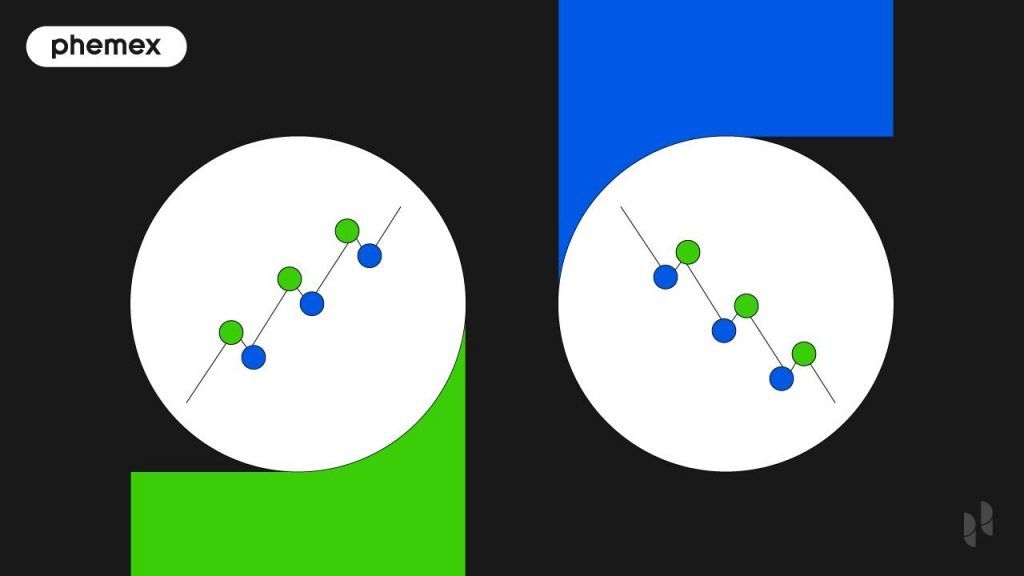OHLC charts graphically represent price action over a set period of time for assets such as bonds, stocks, commodities, and cryptocurrencies. When combined with other financial tools, these charts are a great way to predict price movements.

What Does OHLC Stand For?
The abbreviation OHLC stands for four criteria of an asset’s price over a specific period of time:
- O: open price
- H: high price
- L: low price
- C: close price
Prices are determined over a specific period of time, such as a minute, hour, day, or week. Different symbols can be used to represent the four criteria collectively, and these symbols are often plotted into an OHLC chart.
What Does an OHLC Chart Look Like?
An OHLC chart illustrates a number of sequential OHLC symbols that visually represent the open, the high, the low, and the close of an asset during a period of time. A sample OHLC bar chart is illustrated below.

An OHLC bar chart (Source: datavizcatalogue.com)
This chart includes three OHLC symbols plotted along an x and y graph. The y-axis represents a pricing scale of the asset. Here, the pricing scale extends from $0 to $400.
The chart also includes a time scale provided along the x-axis. The time scale is segmented into equal increments. Here, the time scale is segmented into 24-hour periods, or Days 1, 2, and 3.
This bar chart also includes one OHLC symbol for each of the segmented time periods. For example, the first OHLC symbol in the sequence (denoted in red) represents the four OHLC price points for the asset during the first timing segment of the sequence (Day 1).The composition of each of these symbols will be discussed later in this article.
In typical OHLC charts, symbols are provided in black. But they may also be colored to visually represent whether the asset’s price went up or down during the particular time frame. For example, the leftmost OHLC symbol in the chart above is represented in red, which designates a bearish day, where the price of the asset went down. The second OHLC symbol in the sequence is a green symbol, designating a bullish day, where the price of the asset went up.
How Are Different Types of OHLC Chart Symbols Structured?
Most OHLC charts use either a bar chart symbol or a Japanese chart symbol, also referred to as candlestick chart symbol.
OHLC Bar Chart Symbols
There are generally two types of bar chart symbols: a bullish symbol and a bearish symbol.
A Bullish Bar Chart Symbol

A bullish bar chart symbol (Source: FinVids.com)
Shown above is a bullish OHLC bar chart symbol. This symbol includes multiple visual cues that represent the price action of a particular asset over a period of time:
- A primary bar extends vertically from the designated “low” to the designated “high.” The length of this primary bar represents a pricing range of this asset during a particular period of time.
- Each of two horizontal tick marks branches off at a right angle from the primary bar. The positions of these two tick marks are compared to determine whether the symbol represents a bullish or bearish period.
- The left-hand tick mark is designated as “open,” and indicates the asset’s price at the initial point in the specified time period. For example, if the time scale for this bar chart is segmented into days, the open mark represents the price at the start of the day.
- The right-hand tick mark is designated as “close.” As the close tick mark in the symbol shown above is greater than the open tick mark, this symbol represents a bullish period.
A Bearish Bar Chart Symbol
The image below represents a bearish bar chart symbol.

A bearish bar chart symbol (Source: FinVids.com)
In this bearish OHLC symbol, the closing price — “close” — is lower than the open price — “open.” Therefore, this symbol designates a bearish time period. This is what traders refer to as a “down day.” In a down day, sellers are active in pushing prices lower to the close of the time period.
Japanese or Candlestick Symbol
Like the bar chart symbol, a Japanese or candlestick symbol is a way to graphically represent the open, high, low, and close price points.

A bullish candlestick symbol (Source: commons.wikimedia.org)
As illustrated, the candlestick symbol includes a main rectangular body that extends vertically from the open to the close. This vertical distance from the open to the close represents the pricing range that the asset experienced during this specific period of time.
This candlestick symbol represents a bullish symbol, since during this time period, the price moved from a lower open price to a higher close price (as noted by the green arrow).
For certain charts, when the close was higher than the open, the rectangular body is filled in (here with green) or is all black as a quick visual cue. A green or all-black candlestick body represents a bullish symbol or an up day.
Alternatively, an empty rectangular body or one that is colored red designates that the open was lower than the close. Such a candlestick body represents a bearish symbol or a down day.
Depending on the asset’s price action, candlestick symbols may also include two “shadows” or “wicks.” The first extends above the rectangular body and the second extends below the body. The shadows designate the highest and the lowest prices achieved during the designated time period. As we will see, some symbols may not have shadows or wicks.
Below is an example of a bearish candlestick symbol.
 A bearish candlestick symbol (Source: commons.wikimedia)
A bearish candlestick symbol (Source: commons.wikimedia)
In this symbol, the open is above the close (as noted by the red arrow). Because it is a bearish candlestick symbol, the rectangular body is colored red.
How To Read an OHLC Chart?
Several techniques are used to interpret OHLC symbols. We summarize a few of them below.
Vertical Height
The vertical height of an OHLC symbol is an indication of the asset’s price swings. The greater the price swing or range of the prices, the greater the vertical height or length. A symbol having a large range over a given period of time is often characteristic of a volatile asset.
Open and Close Positioning
The position of the open and the close tells technical traders where the asset opened and closed relative to its high and low.
If the asset had a large positive wick, but the close was much lower than the high, traders assume that the buying spree died down toward the end of the period. If the asset had a large negative wick, but closed much higher than its low, selling died down toward the end of the period.
The market may be undergoing a period of indecision where the open and close are close together, as neither buyers nor sellers could make much progress in either direction. If the close is far below the open, the asset experienced strong selling during the period.
Alternatively, if the close is far above the open, it shows that there was strong buying during the period.
Trends
A sequential clustering of a number of colored green bars can represent an uptrend. And during a downtrend, more red bars than green bars often appear. These types of clusters can provide information on the trend direction and the strength of the trend.

What are Some Common OHLC Symbol Patterns?
Certain commonly occurring OHLC symbols are used to predict potential entry and exit trading positions. A few of the more popular symbols are described below.
Doji
A Doji symbol occurs when the open and close prices are generally equal to one another. The lengths of the Doji’s high and low shadows can vary. If symbols occurring before the appearance of a Doji are bearish or red, the asset may be about to experience a bullish trend.

Doji symbol (Source: DailyFX)
Dragonfly Doji

Dragonfly Doji (Source: DailyFX)
A Dragonfly Doji is a symbol typically formed when the open and the close prices are at the highest of the day. Note that there is no upper shadow stemming from the high. A Dragonfly Doji will typically represent a bullish trend if it has a longer lower shadow. In addition, when the Dragonfly Doji appears at a pricing bottom, the market may be moving in a reverse direction.
Hammer

White (bullish) and black (bearish) candlestick (Source: incrediblecharts.com)
The hammer can be either a bullish or bearish candlestick. It consists of a small body near the high, with little or no upper shadow and a long lower shadow. Both illustrated hammers above are considered bullish if they are formed during a bearish trend.
Marubozu

Bullish and bearish Marubozu signals (Source: incrediblecharts.com)
Marubozu signals are represented by a long candlestick main body with no upper or lower shadow. These signals can either be bullish or bearish.
A bullish Marubozu signal comprises of a long main body and is formed when the open equals the low, and similarly where the close equals the high. This signal indicates that buyers controlled the price of the asset from the start of the trading period to the close. It is therefore considered a strong bullish signal.
A bearish Marubozu candle comprises of a long black (or red) body and appears when the open equals the high for the period and the close equals the low for the period. A bearish Marubozu indicates that sellers controlled the price from the opening to the close.
OHLC Bitcoin Candlestick Chart: An Example
 Bitcoin 1-minute OHLC candlestick chart (Source: phemex.com)
Bitcoin 1-minute OHLC candlestick chart (Source: phemex.com)
The above illustrates a Bitcoin (BTC) OHLC candlestick chart based on one-minute time segments. This chart illustrates a few of the common OHLC symbols summarized above.
For example, at around 14:01, a sequence of two red candlesticks demonstrates the start of a downtrend, even though the Open of the second candlestick is greater than the Close of the first candlestick.
Then, a green Doji appears. Since the symbols occurring before the appearance of this Doji are bearish, this Doji is an indication that BTC is about to experience a bullish trend. Which is does, starting at 14:04.
This bullish trend continues until a bearish hammer appears at 14:06. As this hammer is formed during this bearish trend, it is considered bullish signal for an uptrend.
Shortly thereafter, a sequence of green candlesticks demonstrates this uptrend. This uptrend includes a green Marubozu signal, showing signs of continued bullishness.
A short bearish trend follows thereafter, until a bullish Doji provides an indication of a possible bullish trend.

Conclusion
Both types of OHLC symbols — bar symbols and candlestick symbols — are excellent tools for predicting an asset’s price action. With a glance, these symbols quickly and succinctly tell the trader four important characteristics of a particular asset over a set period of time: the open, the high, the low, and the close.
Read More
- The 8 Most Important Crypto Candlestick Patterns
- How to Read Crypto Charts: Learn Trading Chart Patterns
- What are Highs and Lows in Trading: The World of Financial Highs and Lows
- What are Harmonic Patterns: Predicting Future Price Actions
- Doji Candlesticks: What They Are and How To Use Them
- All About Reversal Candles: How to Read and Trade
- Stochastic Oscillator: Everything You Need To Know
- Crypto Price Action Trading Strategy









